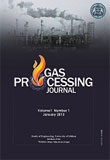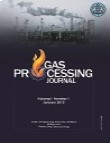فهرست مطالب

Gas Processing Journal
Volume:3 Issue: 2, Autumn 2015
- تاریخ انتشار: 1394/10/14
- تعداد عناوین: 6
-
-
Page 1This study mainly focuses on enhancing the overall efficiency of gas transmission networks. The authors developed a model with detailed characteristics of compressor and pressure reduction stations. Following this, they suggested three different systems with gas turbine including: organic rankine cycle (ORC), air bottoming cycle (ABC), and ABC along with steam injection (SI-ABC). In addition, use of turbo-expander as a good alternative to the expansion valves was also studied. Performance of proposed cycles was investigated on a real case study for natural gas transmission network. Results showed that the highest efficiency would be obtained with ORC system where n-pentane was used as the working fluid and turbo-expander was considered in pressure reduction stations Moreover, the efficiency improvement was estimated to be 22% averagely in comparison with the existing network where the flow was in the span of 50 up to 90 MMSCMD.Keywords: Natural Gas Transmission Network, Organic Rankine Cycle, Air Bottoming Cycle, Steam Injection Air Bottoming Cycle, Turbo, Expander, Overall Efficiency
-
Page 27Several processes have been proposed for natural gas liquefaction due to the vast utilization of LNG as a reliable and relatively easy to use fuel. Even though the merits and demerits of different process have been studied, a dearth of comprehensive technical and economical comparative investigation of these methods makes further broad examination a necessity. This article is presented to address this necessity. In this study, five different processes (MFC-Linde, DMR-APCI, C3MR-Linde, SMR-APCI, and SMR-Linde) were inclusively compared and ranked considering eight most relevant indices, namely power consumption, coefficient of performance, specific energy consumption, exergy efficiency, LNG production rate, refrigerant rate, number of equipment, and energy improvement potential. The comparison and ranking of these processes were carried out by analytic hierarchy process (AHP). The results indicated that DMR-APCI process was in the first rank. In this article, the variations of model resulted in change in the impact weight of each criterion and their effect on the aggregate priority of the alternative LNG processes was also assessed.Keywords: Liquefied Natural Gas, LNG Process, Analytic Hierarchy Process, Ranking
-
Page 49The present sought to draw a comparison between Model Predictive Control performance and two other controllers named Simple PI and Selective PI in controlling large-scale natural gas transport networks. A nonlinear dynamic model of representative gas pipeline was derived from pipeline governing rules and simulated in SIMULINK® environment of MATLAB®. Control schemes were designed to provide a suitable pressure at consumers nodes by varying the refinery production rate and compressor station output pressure in the middle of pipeline. The results showed that the model predictive control significantly outperformed the other two methods in economic controlling of pipeline by using less energy in compressor station and simultaneously rejecting disturbances. Although MPC controller performed better, it had a more complicated structure and difficult design procedure than PI controllers.Keywords:Keywords: Gas Transport Pipeline, Model Predictive Control, PI Control, Selective Control
-
Page 59In recent years, using new methods in utilization of energy resources has become necessary due to environmental pollution and restriction of energy resources. The hybrid system presented in this article produced power with SOFC and Stirling engine. The purpose is to analyze a 50 kW Solid Oxide Fuel Cell that could produce enough thermal energy for a 10 kW Stirling engine working in the hybrid system. The hybrid system analysis is performed by programming in Matlab and modeling in Hysys. Thermodynamics and electrical parameters of the system are calculated in two ways. The results are close to each other and confirmed the validity of calculations.Keywords: SOFC, Stirling, Hybrid system, Modeling, Hysys, Matlab
-
Page 71This study presents a review on advanced oxidation processes (AOP) for simultaneous removal of NO and SO2. AOP is based on using a strong oxidant such as ozone and H2O2 which is able to generate highly reactive intermediates. The pollutant will be oxidized and removed by these intermediates. In recent years, AOP has been considered as an effective and attractive technology in the field of flue gas purification.
In this paper, first, a brief overview on conventional methods for NOx removal is presented. Then the concepts of AOP are explained and the different AOPs are introduced. Since, H2O2 is widely used as a chemical oxidant in advanced oxidation processes, the most attention in this article is paid to the advanced oxidation with H2O2. On the other hand, the photochemical method (applying UV light) for producing active radicals in advanced oxidation process has become an attractive issue in recent years. Thus, the main focus of this study is on UV/H2O2 advanced oxidation process. The concepts, status of progress and attractive issues for future researches are discussed.Keywords: AOP, UV, H2O2, Removal of SO2, NO, Reactive Absorption -
Correlation and Prediction of Acid Gases Solubility in Various Aqueous Alkanolamine Solutions Using Electrolyte Cubic Square-Well Equation of StatePage 75The object of this work is solubility correlation and prediction of CO2 and H2S in various aqueous alkanolamines using the electrolyte cubic square-well equation of state (eCSW EoS) [Haghtalab, A.,Mazloumi, S. H., (2009a), Fluid Phase Equilib.,285,96-104]. The eEoS systematically is applied to describe the solubility of acid gases in various alkanolamine solutions, including MDEA, MEA, DEA, AMP, DIPA, TEA, DGA and PZ. In calculations of chemical equilibrium all of the molecular and ionic species have been taken in to account. Also, in order to improve the modeling, the N2O analogy method was used to calculate the molecular interaction parameters in binary acid gas and alkanolamine solutions. The results of the method are in good agreements with experiments. To investigate the accuracy of the modeling, the simultaneous solubility of mixed CO2 and H2S in aqueous MEA, DEA, MDEA, TEA and AMP solutions are also predicted. Acceptable results were achieved for the quaternary systems. In this work, over 3000 experimental data points were used in order to correlate and predict the solubility of CO2 and H2S in the various alkanolamine solutions.Keywords: Modeling, Alkanolamines, Acid Gas Solubility, N2O Analogy, Electrolyte CSW EoS


